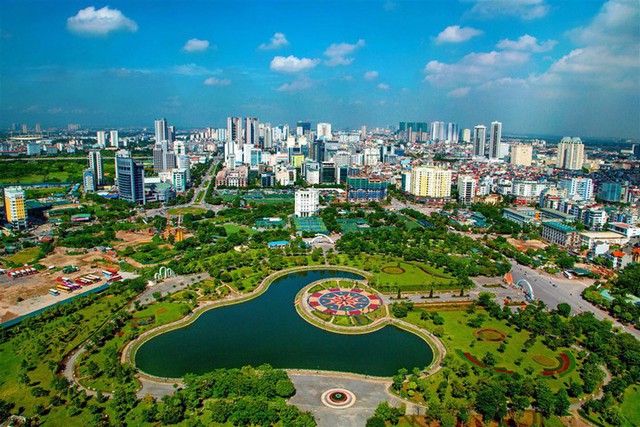Two-tier local government system shows initial stability and efficiency
VGP – After two months of implementation, Ha Noi’s two-tier local government model has demonstrated encouraging results, laying the groundwork for a coherent and cohesive administrative structure.

Ha Noi from above
The city swiftly set up and stabilized the organizational apparatus of 126 newly established communes and wards. However, the model also presents challenges related to staffing, technological infrastructure, and coordination mechanisms that require timely solutions.
Mobilizing over 5,250 personnel for grassroots Party Committees
According to Nguyen Hong Nhat, Deputy Head of the Ha Noi Party Committee's Organization Commission, the new system has delivered positive outcomes in its early stage, ensuring stability and continuity.
All 126 commune- and ward-level Party Congresses for the 2025–2030 term were successfully held. To support the model, the Standing Committee of the Ha Noi Party Committee transferred 5,258 officials, public employees, and civil servants from municipal Party and corporate units to serve at local Party Committees.
A comprehensive and timely legal framework has also been introduced to facilitate operations, with essential reorganizations completed promptly to avoid administrative disruptions. Socio-economic development, national defense, and security have been effectively maintained. Budget management, cultural programs, and social welfare activities have been carried out smoothly, while decentralization and delegation of authority have strengthened the stability of the new system.
Improving frameworks and strengthening training
Still, he acknowledged shortcomings such as uneven development among communes and wards, an unsuitable organizational structure, and stretched staffing capacity. To address these issues, Ha Noi will reorganize its workforce, engage experts to review structures and staffing quotas, and enhance training to improve officials' professional competence.
Permanent Deputy Secretary of the Ha Noi Party Committee Nguyen Van Phong also noted that the system has achieved initial stability, with many units showing progress despite difficulties. Yet challenges remain, including personnel shortages, limited qualifications and skills, and underdeveloped IT infrastructure.
Looking ahead, the Ha Noi Party Committee will compile a comprehensive list of problems to be addressed, prioritize capacity-building and grassroots training, and ensure stronger coordination with central agencies. Nguyen Van Phong emphasized that only by enhancing the qualifications of officials and aligning institutional frameworks can the two-tier government model fully demonstrate its effectiveness and contribute to Ha Noi's rapid and sustainable development.
Earlier, on July 1, Ha Noi officially launches a two-tier local administration model, comprising the municipal and commune/ward levels, marking a historic milestone in the capital city's ongoing administrative reform process.
On September 26, the Politburo and the Party Central Committee's Secretariat on September 26 issued Conclusion No. 195-KL/TW on the performance of the political system and two-tier local administration since July 1, 2025.
The Politburo and the Secretariat acknowledged Party committees at all levels for their swift, proactive, and serious implementation of assigned tasks. They were praised for fulfilling many tasks ahead of schedule, addressing challenges, and promptly resolving issues arising in practice to ensure the smooth and effective operation of the political system and two-tier local administration.
Ministries, sectors, and localities were demanded to push ahead with implementing Plan 02-KH/BCD on digital transformation within the political system, dated June 19, 2025, of the Steering Committee for Resolution 57, and swiftly deal with shortcomings and obstacles linked with institutional frameworks, infrastructure, technology, and personnel as pointed out in the report of the Party Central Committee's Inspection Commission.
Starting July 1, Viet Nam's is implementing a two-tier local administration model nationwide, comprising 34 provinces and cities (reduced from 63), with districts abolished under the biggest restructuring in the country's history.
This marks the first time in the history of administrative reform that Viet Nam has carried out a large-scale restructuring, reducing intermediate layers and forming a leaner, stronger and more effective administrative apparatus towards better serving the people.

